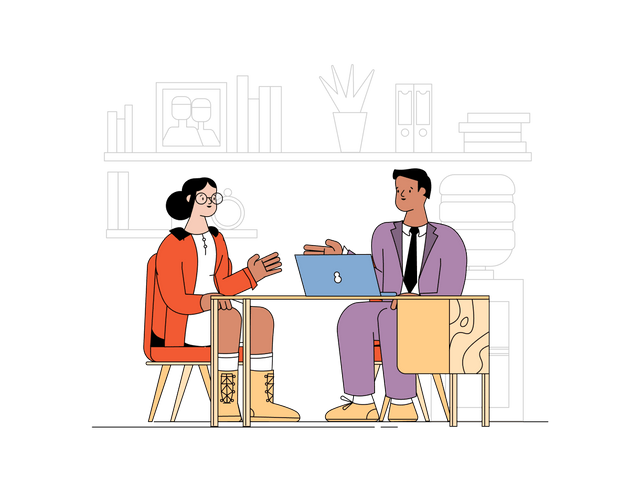You've probably heard the term 'unstructured interview' before. What does it mean exactly? How should you prepare for it? Learn more: https://blog.hirenest.com/structured-vs-unstructured-interview/

Unstructured interviews are often used by recruiters or hiring managers who want to get a better understanding of candidates. They ask questions without giving them much guidance beforehand.
This type of interview is usually conducted over the phone or via video chat. The interviewer asks open-ended questions and lets the candidate talk freely. This method allows the recruiter to see how well they communicate and interact with other people.
In this article we will discuss some tips to help you ace unstructured interviews.
It's important to note that most companies don't conduct unstructured interviews anymore because they find them too inefficient. Instead, they prefer structured interviews where they give you specific instructions and guidelines ahead of time. These types of interviews tend to be less stressful and allow you to focus more on answering the question than thinking about what to say next.
The best way to prepare for an unstructured interview is to practice at home. Try asking yourself questions like "What would I do if I were interviewing someone?" or "How could I improve my communication skills?". Then try talking through each scenario with a friend or family member.
If you're looking for a job, then you'll likely face many different kinds of interviews. Some employers may invite you to come into the office for a one-on-one conversation; others might send you an email inviting you to apply online. Others still may require you to fill out a form and submit it along with a resume.
Differences Between Structured and Unstructured Interview
The interviewee may not always know what he/she wants to say. This is called “unstructured interviewing.” In this case, the interviewer has to ask questions in order to find out what the person wants to talk about. You can find out more in our article: https://blog.hirenest.com/structured-vs-unstructured-interview/
The interviewee will usually feel uncomfortable if the interviewer asks too many questions at once. It is important to give him/her enough time to answer each question before moving on to another one.

The interviewee should be given plenty of time to think about his/her answers. If the interviewee does not seem comfortable answering a particular question, it is better to move on to another topic rather than pressing him/her further.
How do I choose a career?
There are several factors that influence our choice of careers. These include personal interests, family responsibilities, financial considerations, and opportunities available. Some people may find certain jobs more interesting than others, but they all require hard work and dedication.
A career change is often necessary because we grow older and develop new skills and knowledge. This means that we must constantly update ourselves so that we remain relevant in our field. Career changes can be difficult, especially if we lack experience in a different area. But this is why we need to take risks and try out new things.
What are the advantages of a structured interview?
The most important advantage of a structured interview is that it provides a standardized way to evaluate candidates. This helps ensure consistency across interviews and makes it easier to compare candidates against one another. It also allows recruiters to identify trends in performance during the interview process. For example, if a candidate consistently answers poorly on a particular question, then this may indicate they lack the necessary skills to perform well at work.
A structured interview should include a combination of both behavioral and cognitive tests. Behavioral tests measure a person’s ability to do specific tasks, while cognitive tests assess whether someone has the knowledge required to complete those tasks. These two types of tests provide different information but together help determine whether a job applicant will succeed in the role.
![Structured vs Unstructured Interview]https://blog.hirenest.com/wp-content/uploads/2022/04/Structured-vs-Unstructured-Interview-4.webp)
Cognitive tests are often used to test applicants’ reasoning abilities, memory, attention span, problem solving, and critical thinking. They are typically administered using paper-and-pencil tests, although some companies now offer computerized versions. Some employers prefer to administer cognitive tests through phone screens because they believe it gives them better insight into a candidate’s personality traits.
In addition to testing for cognitive skills, many companies conduct behavioral assessments to see how people behave under pressure. Common examples include the Myers–Briggs Type Indicator (MBTI) and the Hogan Development Survey. Both of these tools attempt to classify individuals based on their behavior and preferences. While these tests aren’t perfect, they can give recruiters valuable insights into how a potential employee would fit within the company culture.
What are the advantages of an unstructured interview?
The main advantage of this type of interview is that it allows candidates to demonstrate their skills without being constrained by a rigid structure. It also gives employers a chance to see if they like working with someone who has different ideas from them.
This approach is particularly useful for people who don't want to do formal interviews but still want to show off their skills. For example, if you're applying for a job at a company where you've worked before, then you might not want to spend too long talking about what you did last week, because you'll look like you're bragging. Instead, you could talk about something you enjoyed doing during your previous role.
![Structured vs Unstructured Interview]https://blog.hirenest.com/wp-content/uploads/2022/04/Structured-vs-Unstructured-Interview-3.webp)
Interviewers should ask questions that will help them understand whether the candidate's strengths match the needs of the organisation. They should try to find out why the person wants to work for them, what motivates them, and what makes them stand out from others.
Conclusion
In order to understand what makes one candidate more qualified than another, interviewers need to ask questions that help them learn about the candidates' strengths and weaknesses. This type of interviewing technique is called structured interviewing. It's also known as behavioral interviewing. Behavioral interviews are used by recruiters to find out whether someone has the skills needed to succeed in a particular job. They're also used by hiring managers to determine whether a candidate is right for the company.
A common mistake people make when they first start working from home is not having any structure at all. If you don't set aside specific times for work, you'll never finish anything. And if you do manage to stay focused, you won't be able to concentrate long enough to actually produce quality content. f you want to know more about Structured vs Unstructured Interview: Which Is Better 2022?, read this article: https://blog.hirenest.com/structured-vs-unstructured-interview/